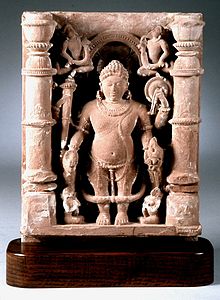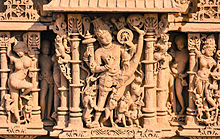Vamana

Vamana ( Sanskrit वामन Vāmana ) is a diminutive deity in Hinduism and the fifth incarnation of Vishnu .
According to Indian mythology , the first four incarnations of Vishnu took place in the first of the four world ages , the Krita-Yuga . His fifth embodiment is considered to be the first in the second age, the Treta-Yuga . At that time there were already three worlds: heaven, earth and the underworld.
myth
The Puranas report (→ web link) how the virtuous King Bali, through great piety and asceticism, had achieved rule over heaven, earth and the underworld. In the eyes of the heavenly devas , this was too presumptuous in Bali, they saw their supremacy wane. As always, when the Dharma , i.e. the cosmic law and human order, were threatened, they called on Vishnu to help him so that he could come down to earth to restore the Dharma. Vishnu came up with a ruse. He surprised King Bali with a spiritual exercise and met him in the form of the inconspicuous dwarf Vamana. He humbly asked for three steps of land for his fireplace. Bali was stunned by this ridiculous request from his mouth and granted it. Then the dwarf transformed into his cosmic form, which consists of all gods ( Trivikrama ). The myth describes the divine splendor and immensity it radiates:
- The moon and the sun are his eyes, the sky his head, the earth his feet, constellations in his gaze, the rays of the sun his hair, stars his pores .
With two steps he crossed heaven and earth; before the third he pauses and leaves Bali the unfathomable depth, the region of the underworld.
Representations
Vamana representations have been known in Indian sculpture since the 4th century (→ Weblink); the existence of older wooden portraits is likely, but no longer provable. On the one hand, Vamana is depicted as a short, potbellied man with the attributes Vishnu (club ( gada ), throwing disc ( chakra ), snail horn ( shankha ) and lotus ( padma ) or chain ( mala )) in his hands; Much more frequent and representative, however, is the depiction of trivial drama , i.e. H. the scene of the god Vishnu, often eight-armed, developed to full size and with one leg, who, in addition to his usual attributes, holds other weapons in his hands (e.g. sword and shield).
In some medieval cases, but especially in modern paintings and prints, this diminutive avatar of Vishnu is identified by an umbrella ( chhatra ) that he carries in his hand. Sometimes this is also found alone as a symbol; it is also regarded as a distinguishing mark of the Indian priests from the Brahmins caste .
literature
- Peter and Anneliese Keilhauer: Imagery of Hinduism. The Indian world of gods and their symbolism. DuMont, Cologne 1983. ISBN 3-7701-1347-0 , pp. 88ff.
Web links
- Vamana / Trivikrama - Photos + Info (English)
- Vamana / Trivikrama - Pictures + Story (English)
Individual evidence
- ↑ Veronica Ions: Indian Mythology. Hamlyn Publ., London 1988, ISBN 0-600-34285-9 , pp. 49ff

